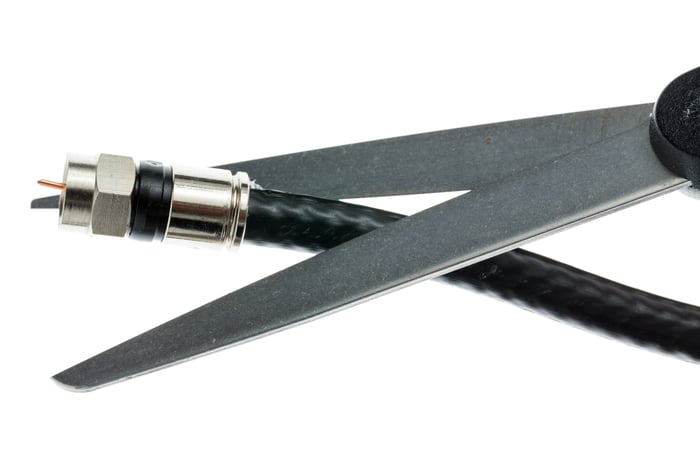There are a number of societal shifts happening in the midst of the COVID-19 pandemic that will outlast the outbreak itself.
Consumers are shifting more of their purchases to e-commerce, telemedicine and digital healthcare are gaining wider acceptance, and viewers are turning to streaming video in greater numbers than ever before for their in-home entertainment.
Economic insecurity and uncertainty about the future is also accelerating another trend that was already gaining steam -- cord-cutting. That, combined with greater adoption of streaming services, may hasten the death of cable according to a recent survey.

A host of new viewing options at lower prices will hasten the death of cable. Image source: Getty Images.
Mounting evidence
The onset of the coronavirus pandemic appears to be accelerating the cord-cutting shift. In a survey of 2,600 people in the U.S., a whopping 64% of respondents said they have cut the cord, are planning to, or never subscribed to cable in the first place. To further highlight the issue, of those households that still have cable, 11% said they plan to cut the cord before the end of 2020.
The numbers were even starker among those between the ages of 18 and 34, with the total jumping to 74%. This group of consumers is highly prized by advertisers because they are at the stage where they are beginning to build brand loyalty and also due to their high disposable income. The survey was conducted by The Trade Desk (TTD -3.84%).
"With only a quarter of young adults having any long-term interest in traditional cable TV, in a few years we won't be talking about linear or cable TV at all. It will all be online and streaming," said Brian Stempeck, chief strategy officer for The Trade Desk.
The survey also includes a cautionary tale for subscription-only streaming platforms. 35% of consumers said they would rather watch free streaming with advertising, or accept limited advertising if it means a cheaper subscription, compared to 31% who say they would rather pay a subscription in order to skip the advertising.
The growing trend of cord-cutting
AT&T (T -0.48%), Comcast (CMCSA -0.74%), Charter Communications (CHTR -2.06%), and Dish Network (DISH) are the largest pay-TV operators in the U.S., and viewers are abandoning them in greater numbers than ever before.
In 2019, the biggest pay-TV providers lost more than 4.9 million customers overall, the largest single-year decline in cable TV history, according to Leichtman Research Group. This accelerated from losses of 2.87 million in 2018 and 1.49 million in 2017.
Those who ditch cable are increasingly adding streaming video subscriptions. Data released by The Motion Picture Association of America (MPAA) last year showed that the number of streaming video subscribers surpassed cable customers for the first time in 2019, so the writing is on the wall.

Image source: Getty Images.
Not all viewing is created equal
The quarterly results of two companies help further illustrate the current environment that's accelerating the trend. When Netflix (NFLX -0.35%) released its first quarter report last week, the results were startling. The company added 15.8 new subscribers, up 23% year over year, and more the double the 7 million it previously forecast. In its more mature U.S. market, Netflix added 2.3 million additional subscribers, up 23% year over year, and growing fourfold sequentially.
The Trade Desk itself is a good barometer for the changes occurring in consumer viewing patterns. The company's technology uses high-speed computer programs and algorithms to best match ads with the right customer, but its growth has been spurred by new advertising channels. In 2019, revenue grew 39% year over year, clocking in at nearly 10 times the rate of the overall ad industry, but the growth in connected TV revenue -- which is largely tied to ad-supported streaming services -- grew 137% year over year.
The death of cable?
It's important to note that it will be years until cable as we know it is gone. That said, the paradigm shift that's occurring in consumer viewing preferences has been accelerated by the COVID-19 pandemic, potentially shaving years of cable's ever-shortening lifespan.




